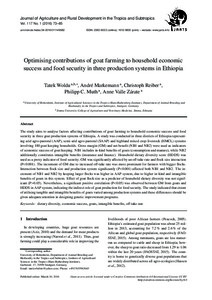Optimising contributions of goat farming to household economic success and food security in three production systems in Ethiopia
| dc.date.accessioned | 2016-04-19T08:50:12Z | |
| dc.date.available | 2016-04-19T08:50:12Z | |
| dc.date.issued | 2016-03-10 | |
| dc.identifier.issn | 1612-9830 | |
| dc.identifier.issn | 2363-6033 | |
| dc.identifier.uri | urn:nbn:de:hebis:34-2016011149582 | |
| dc.identifier.uri | http://hdl.handle.net/123456789/2016011149582 | |
| dc.language.iso | eng | |
| dc.publisher | Kassel University Press | ger |
| dc.rights | Urheberrechtlich geschützt | |
| dc.rights.uri | https://rightsstatements.org/page/InC/1.0/ | |
| dc.subject | dietary diversity | eng |
| dc.subject | economic success | eng |
| dc.subject | goats | eng |
| dc.subject | intangible benefits | eng |
| dc.subject | off-take rate | eng |
| dc.subject.ddc | 630 | |
| dc.title | Optimising contributions of goat farming to household economic success and food security in three production systems in Ethiopia | eng |
| dc.type | Aufsatz | |
| dcterms.abstract | The study aims to analyse factors affecting contributions of goat farming to household economic success and food security in three goat production systems of Ethiopia. A study was conducted in three districts of Ethiopia representing arid agro-pastoral (AAP), semi-arid agro-pastoral (SAAP) and highland mixed crop-livestock (HMCL) systems involving 180 goat keeping households. Gross margin (GM) and net benefit (NB1 and NB2) were used as indicators of economic success of goat keeping. NB1 includes in-kind benefits of goats (consumption and manure), while NB2 additionally constitutes intangible benefits (insurance and finance). Household dietary diversity score (HDDS) was used as a proxy indicator of food security. GM was significantly affected by an off-take rate and flock size interaction (P<0.001). The increment of GM due to increased off-take rate was more prominent for farmers with bigger flocks. Interaction between flock size and production system significantly (P<0.001) affected both NB1 and NB2. The increment of NB1 and NB2 by keeping larger flocks was higher in AAP system, due to higher in-kind and intangible benefits of goats in this system. Effect of goat flock size as a predictor of household dietary diversity was not significant (P>0.05). Nevertheless, a significant positive correlation (P<0.05) was observed between GM from goats and HDDS in AAP system, indicating the indirect role of goat production for food security. The study indicated that extent of utilising tangible and intangible benefits of goats varied among production systems and these differences should be given adequate attention in designing genetic improvement programs. | eng |
| dcterms.accessRights | open access | |
| dcterms.bibliographicCitation | In: Journal of Agriculture and Rural Development in the Tropics and Subtropics. Kassel : Kassel University Press. - Vol. 117, No. 1 (2016), S. 73-85 | |
| dcterms.creator | Woldu, Tatek | |
| dcterms.creator | Markemann, André | |
| dcterms.creator | Reiber, Christoph | |
| dcterms.creator | Muth, Philipp C. | |
| dcterms.creator | Valle Zárate, Anne | |
| dc.description.everything | Gedruckte Ausg. im Verlag Kassel Univ. Press (www.upress.uni-kassel.de) erschienen. | ger |
Dateien zu dieser Ressource
Das Dokument erscheint in:
-
Vol 117, No 1 (2016) [15]

